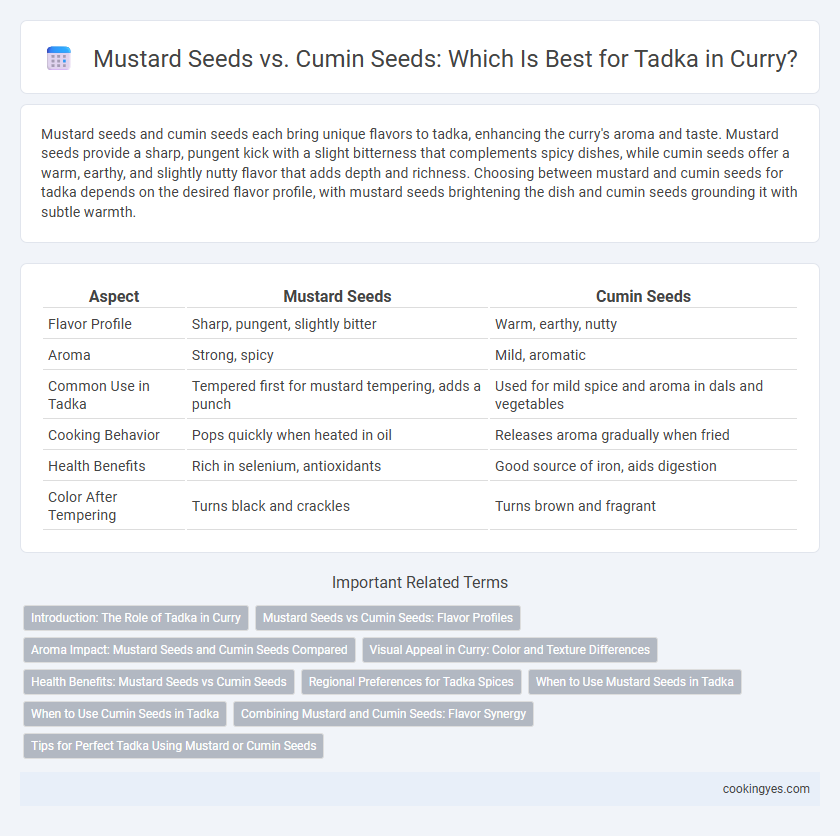Mustard seeds and cumin seeds each bring unique flavors to tadka, enhancing the curry's aroma and taste. Mustard seeds provide a sharp, pungent kick with a slight bitterness that complements spicy dishes, while cumin seeds offer a warm, earthy, and slightly nutty flavor that adds depth and richness. Choosing between mustard and cumin seeds for tadka depends on the desired flavor profile, with mustard seeds brightening the dish and cumin seeds grounding it with subtle warmth.
Table of Comparison
| Aspect | Mustard Seeds | Cumin Seeds |
|---|---|---|
| Flavor Profile | Sharp, pungent, slightly bitter | Warm, earthy, nutty |
| Aroma | Strong, spicy | Mild, aromatic |
| Common Use in Tadka | Tempered first for mustard tempering, adds a punch | Used for mild spice and aroma in dals and vegetables |
| Cooking Behavior | Pops quickly when heated in oil | Releases aroma gradually when fried |
| Health Benefits | Rich in selenium, antioxidants | Good source of iron, aids digestion |
| Color After Tempering | Turns black and crackles | Turns brown and fragrant |
Introduction: The Role of Tadka in Curry
Tadka, a tempering technique in Indian curry, elevates flavor by releasing essential oils from spices like mustard seeds and cumin seeds. Mustard seeds impart a sharp, pungent aroma that enhances spicy curries, while cumin seeds offer a warm, earthy fragrance suited for milder dishes. Choosing between mustard and cumin seeds in tadka depends on the desired taste profile and the specific curry recipe.
Mustard Seeds vs Cumin Seeds: Flavor Profiles
Mustard seeds impart a sharp, pungent, and slightly bitter flavor that intensifies when tempered in hot oil, adding a distinct aroma to tadka. Cumin seeds offer an earthy, warm, and nutty taste with a subtle sweetness, enhancing depth and complexity in dishes. The choice between mustard and cumin seeds for tadka significantly influences the flavor profile, with mustard seeds providing a bold, vibrant punch and cumin seeds delivering a mellow, aromatic warmth.
Aroma Impact: Mustard Seeds and Cumin Seeds Compared
Mustard seeds release a sharp, pungent aroma with slightly nutty undertones when fried in oil, creating a bold aromatic base for tadka. Cumin seeds emit a warm, earthy fragrance with sweet and peppery notes, adding depth and complexity to the curry's aroma profile. The choice between mustard and cumin seeds significantly influences the tadka's sensory impact, affecting the dish's overall flavor and aromatic balance.
Visual Appeal in Curry: Color and Texture Differences
Mustard seeds create a vibrant pop of color with their glossy black or yellow hues, adding a slight crunch to the tadka, while cumin seeds offer a warm brown tone and a more subtle, earthy texture. The visual contrast of mustard seeds against a bright curry base enhances the dish's overall appeal, making it visually striking. In comparison, cumin seeds blend more seamlessly into the curry's texture, providing depth without overpowering the visual presentation.
Health Benefits: Mustard Seeds vs Cumin Seeds
Mustard seeds are rich in antioxidants and omega-3 fatty acids, which help reduce inflammation and improve cardiovascular health, while cumin seeds contain high levels of iron and aid digestion by stimulating the secretion of digestive enzymes. Both mustard and cumin seeds possess antimicrobial properties that enhance gut health, but mustard seeds also support respiratory function due to their mucolytic effects. Including either seed in tadka not only adds distinctive flavors but also boosts the nutritional profile by promoting metabolism and immune system strength.
Regional Preferences for Tadka Spices
Mustard seeds and cumin seeds are essential spices for tadka, with regional preferences shaping their use across India. In South Indian cuisine, mustard seeds are predominantly used for tadka, imparting a sharp, slightly bitter flavor that enhances dishes like sambar and rasam. In contrast, North Indian kitchens typically favor cumin seeds for tadka, offering a warm, earthy aroma that complements dals and vegetable curries.
When to Use Mustard Seeds in Tadka
Mustard seeds are best used in tadka when a sharp, pungent flavor and slight bitterness are desired, especially in South Indian and Bengali dishes where they add a robust aroma and distinct taste. They pop quickly in hot oil, releasing their nutty and peppery notes, ideal for tempering dals, sambar, and vegetable stir-fries. Use mustard seeds at the very beginning of the tadka process to ensure their flavors infuse the oil effectively before adding other spices or ingredients.
When to Use Cumin Seeds in Tadka
Cumin seeds are ideal for tadka when a warm, earthy aroma and subtle bitterness are desired to enhance the dish's depth. They are best added early in the tempering process, allowing them to release their essential oils and infuse the oil with a rich, nutty flavor. Mustard seeds, in contrast, provide a sharper, pungent taste and are typically used when a more pronounced, tangy kick is preferred in tadka.
Combining Mustard and Cumin Seeds: Flavor Synergy
Combining mustard seeds and cumin seeds in tadka creates a rich flavor synergy, where the pungent, sharp aroma of mustard seeds perfectly complements the warm, earthy notes of cumin seeds. This blend enhances the overall depth and complexity of curry, imparting a balanced, aromatic profile that elevates the dish. The interplay between these spices stimulates the palate, making each bite more vibrant and flavorful.
Tips for Perfect Tadka Using Mustard or Cumin Seeds
For a perfect tadka, use mustard seeds when you want a sharp, pungent aroma that enhances South Indian dishes, ensuring the seeds pop fully in hot oil to release their flavor. Cumin seeds offer a warm, earthy taste best for North Indian curries, so gently toast them in medium heat until they darken slightly without burning. Adjust the quantity to balance the spice, and always add the seeds to hot oil before other ingredients for optimal tempering results.
Mustard seeds vs Cumin seeds for tadka Infographic

 cookingyes.com
cookingyes.com